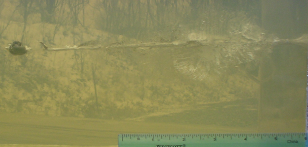Brass Fetcher Ballistic Testing
38 Super is most easily thought of an as elongated 9mm Luger case though the 38 Super was originally based on the 38 Auto cartridge. It was introduced as a high-velocity replacement for the 45 ACP in 1911 pistols. What it is, in fact, is a mid-range 357 Magnum cartridge that will fit in a practically-sized handgun magazine. Firearm lethality closely follows “More’s Law.” More’s Law states: “More is Better.” A fight with firearms is no different conceptually than a boxing match. Speed, accuracy, power and a desire to win are usually what decide the fight. Notice how very few boxing matches are settled in a single-punch knockout. “Fair” fights are usually characterized by the exchange of multiple shots until one of the opponents is knocked out or surrenders.
Firearms are no different. It is important to find a balance between power and controllability in the cartridge that you carry for self-defense. If you don’t want to spend a lot of time shooting, you should select a cartridge that kicks less. Missing a target with a high-recoil, high performance load will cost you time and might endanger your life as a result. As Jeff Cooper used to say: “Accuracy, Power, Speed.” In that order.
My first experience with a Colt pistol was a Series-70 1911 in 38 Super. What a great gun. The higher chamber pressure does indeed make the gun recoil ‘snappier’ than the 45 ACP version. What is also increased is the magazine capacity. Standard 45 ACP handguns will hold 7 rounds in the magazine while the 38 Super holds 9 rounds. Despite a focus on Accuracy, Power and Speed, it is likely that you will have to shoot more than once during a self-defense incident.
If your hand is large enough, then there is no reason not to opt for a double-stack 38 Super handgun—you will have 15-18 cartridges with which to end the fight.
Selecting ammunition is not hard for this cartridge because there is more than enough energy associated with the 38 Super. Most common is the 124gr JHP but 147gr JHP ammunition is also available from the factory. Where the challenge comes in is finding a JHP which will hold up to the increased velocity of the 38 Super. Seldom is fragmentation your friend when we are discussing handgun cartridges. It takes a large handgun or a rifle before fragmentation (from a bullet designed like a traditional JHP) to make a difference in terms of wounding. Below, at left is a video of a JHP which produced fragments that don’t greatly enhance terminal performance; at right is a JHP with useful fragmentation.
It is worth noting that the cartridge on the left is a high-pressure 9mm Luger cartridge while the cartridge on the right is a high-pressure 500 S&W Magnum cartridge. If the 9mm Luger was capable of greater kinetic energy, then the fragments would also have greater kinetic energy. A certain quantity of kinetic energy is necessary in order to break through the gelatin at such a steep angle, as is common with bullets not designed to fragment.
38 Super is right in the middle of these two cartridge but the useful fragmentation is minimal. I recommend a 124gr JHP moving at maximum safe velocity when using a 38 Super for self-defense.
More Info
10-percent Ballistic Gelatin Shot
See how well this caliber stacks up against the FBI performance requirement of expansion and 12.0” or deeper penetration depth.
20-percent Ballistic Gelatin Shot
See how well this caliber stacks up in military-standard performance evaluations.
Results of shots into 10% ballistic gelatin blocks covered in heavy Denim fabric
